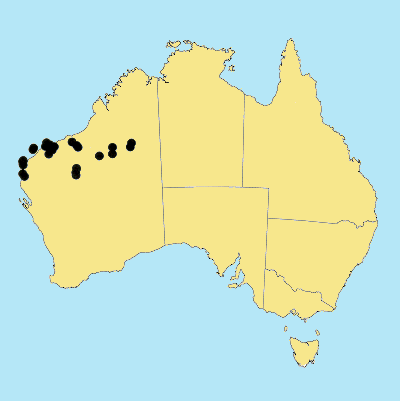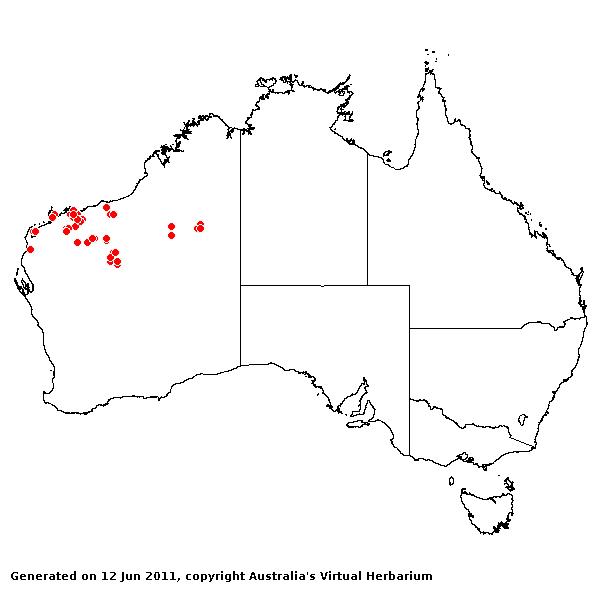Triodia angusta N. T.
Burbidge. J. Roy. Soc. W. Australia 30: 26, (1946).
Classification. (GPWG 2001) : Subfamily Chloridoideae. Triodeae.
Type of Basionym or
Protologue Information: Australia: Coongan Station, Anderson (Burbidge
452).
Key references
(books and floras): [1952] C.A.Gardner, Flora of Western Australia 1
Gramineae (77), [2002] D.Sharp & B.K.Simon, AusGrass, Grasses of
Australia.
Illustrations:
[1952] C.A.Gardner, Flora of Western Australia 1 Gramineae (71,
Pl. 21).
Habit.
Perennial. Stolons present. Culms 50–200 cm tall. Mid-culm internodes glabrous.
Leaf-sheath auricles absent. Ligule a fringe of hairs. Leaf-blades straight or
flexuous, aciculate, conduplicate, 8–20 cm long, 1.2–1.8 mm wide.
Inflorescence.
Inflorescence compound, a panicle of racemes. Racemes appressed, 2–3 cm long.
Central inflorescence axis 10–41 cm long.
Spikelets.
Spikelets pedicelled. Fertile spikelets many flowered, with at least 2 fertile
florets (3–6), comprising 3–6 fertile floret(s), with diminished florets at the
apex, cuneate, laterally compressed or terete, 4–12 mm long.
Glumes.
Glumes similar, thinner than fertile lemma. Lower glume lanceolate, membranous
or scarious, without keels, 1 -nerved. Lower glume surface glabrous. Lower
glume apex mucronate. Upper glume lanceolate, 3–5 mm long, hyaline or scarious,
without keels, 1–3 -nerved. Upper glume surface glabrous. Upper glume apex
entire, mucronate.
Florets.
Fertile lemma 2.5–4 mm long, without keel or keeled, 3 -nerved. Lemma surface
glabrous or indumented. Lemma apex dentate or lobed. Anthers 3.
Continental
Distribution: Australasia.
Australian
Distribution: Western Australia.
Western Australia:
Mueller, Canning, Fortescue, Ashburton, Carnarvon.
Notes.
Allied to T. secunda, but lacks the fringed auricles and hirsute lemmas
of that species. Diagnostic characters include the spiciform racemose
infloresence with secund, biseriate spikelets; unequal mucronate glumes c. 1/2
as long as the spikelet; shortly 3-lobed, almost glabrous, 3-nerved lemmas;
long scabrous-pubescent paleas; stoloniferous often bluish habit. Foliage indumentum
is variable, the sheaths either glabrous or woolly-hairy, with the hairs
sometimes extending to the blade, and the orifice varying from woolly, shortly
pubescent or long-bearded.
N of
the Tropic of Capricorn in the Eremaen Province on mainland and coastal
islands, W.A. On the banks of rivers and creeks; stony watercourses; margins of
salt flats, salt lakes and samphire marshes; coastal shell mounds; calcareous
drainage floors; cracking clay plains and flats; shaley creekbeds; beach sands;
sandy and sandy loam, often red soils; stony gorge hills, valleys and lowlands;
in association with limestone, quartzite and sandstone; flowers all seasons.


